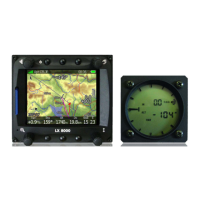LX8000 version 0.96 April 2008
Page 59 of 85
6.2 Altimeter
The altimeter of LX8000 is temperature compensated from -20ºC up to + 60ºC. The
altimeter is calibrated from 0 to 6000m (20,000ft), but indication goes up to 8000m
(26,000ft).
6.2.1 IGC barogram recalibration procedure
LX8000 has an additional pressure sensor for altitude recording. To comply with IGC
procedures, this sensor has no external pneumatic connection. To carry out the barogram
calibration procedure it is necessary to remove the instrument from the glider and place it in
a vacuum chamber. The procedure is as follows:
Switch the instrument ON, and wait some minutes (straight line on the barogram beginning)
Set recording interval to 1 second (see chapter 5.1.2)
Place it in the chamber and carry out a short climb to about 100m (to start flight recorder)
Bring the chamber pressure to exactly 1013.2hPa
Decrease the pressure by 1000m and hold for about 30 seconds
Continue the procedure to 6000m
Increase the pressure in 1000m steps back to 1013.2hPa
After reaching ground wait about 3 minutes and switch the instrument off
Leave the instrument minimum 5 minutes off
Download the last flight and print the barograms using the LXe PC program
Restore flight recorder settings
The barogram will be the last flight in the logbook.
6.3 Speed command
Speed command flying based on the MacCready theory is a very useful tool to optimize cross
country speed. There are many visual indicators (see LCD Vario). When the instrument
changes to speed command mode, the audio will change and become a director informing
the pilot whether he is flying too fast or too slow. In order to reduce confusion between
vario and speed command audio, some special features were developed:
Continuous audio signal in + possible (other kinds of signals can be chosen, see setup)
No audio at correct speed (dead band).
6.4 Final glide calculation
The final glide calculator calculates the final glide altitude difference to the selected point
(APT, TP). In the task mode the final glide is always calculated from the current position,
round all uncompleted turn points to the goal. A + indication will inform the pilot that the
glider is above the final glide slope and vice versa. The final glide takes into account
MacCready setting, wind, bugs and safety altitude.
The elevation of the finish point is imported from the waypoints into the final glide
altitude difference. If this elevation is incorrect, or is set to zero, and the altimeter
is set to QNH, then the final glide will be erratic. It is therefore important that the
elevation of the goal is correctly entered in the waypoints file
FILTER
0.5 to 5
Smart Vario
FILTER
1 to 4 or OFF
RAW
VARIO
FILTERED
VARIO
VARIO
INDICATION

